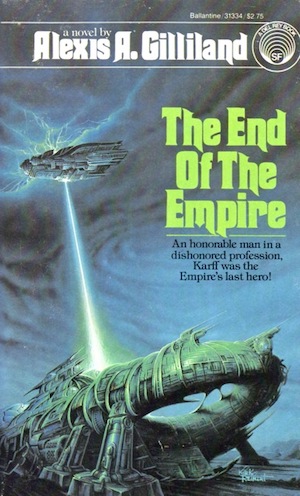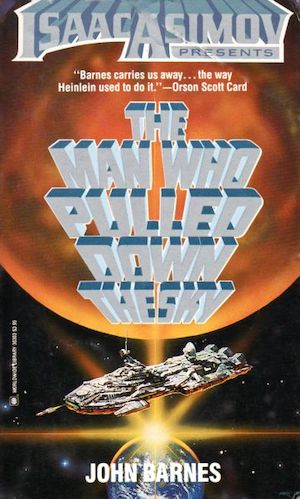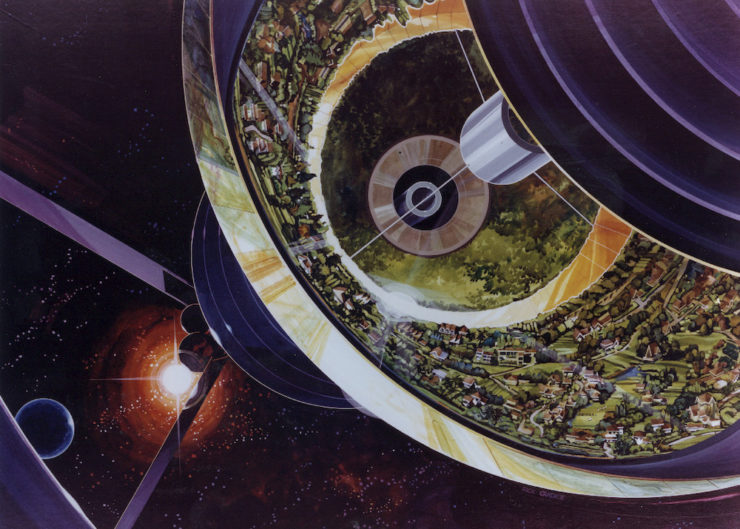As previously discussed, Gerard K. O’Neill’s vision of space colonies was particularly comforting to 1970s anxieties.1 Soaring population? The asteroid belt has enough material to build habitats promising many times the surface area of Earth! Energy crisis? Have said habitats pay for themselves by building solar power arrays IN SPAAACE!2 Indigenous populations weirdly ungrateful for genocidal displacement by Europeans? Colonization do-over in space where there are no natives to displace or complain!
Various factors—primarily that the essential concept was as sound as the Darien Scheme and the technological barriers proved insurmountable—ensured the proposal would come to naught.
Just as well, because had O’Neill’s colonies been realized, their governments would probably be struggling to deal with the 30 percent of their population who been convinced that air is noxious. It’s just a MSM plot to con people into purchasing life support! Free yourself from air dependence—open the airlocks to space!3
At least all this space colony talk inspired some great illustrations!
An interesting aspect of O’Neill’s proposal was that while it caught on with mainstream media, it wasn’t nearly as inspirational to science fiction writers.4 If I had to speculate why, I’d put it down to two elements:
- Space colonies, particularly large ones, are essentially cities.
- L’anglosphere SF authors of this era disliked cities.5
Nevertheless, the space colony concept lingered on into the 1980s and after. Here are five novels—recent in the sense that they were published in the last forty years—featuring space colonies.
The End of the Empire by Alexis A. Gilliland (1983)

A fleet from the Holy Human Empire flees its last stronghold on Portales, hoping to find a refuge in uncharted space. By mere chance (and authorial fiat), the HHE refugees end up the same system settled by Mamnu anarchists who fled Portales nine centuries earlier.
There’s only one thing to do: conquer!
Fearing that their descendants would fall prey to the temptations of government, the founding anarchists established a minarchic government that was powerful enough to prevent more interventionist states from arising while being too weak to fulfil most of the standard functions of government. Under this regime the fortunate enjoy luxury and comfort in orbiting habitats. The masses are dispatched to poorly terraformed Malusia, where from time to time the unreliable infrastructure thins their numbers through famine. This arrangement has endured for nine centuries. It may not survive exposure to ideas (and conquerors) from outside the system.
HHE intelligence officer Colonel Saloman Karff is dispatched to Malusia to provoke a crisis that the HHE remnant can exploit. It is a challenging task, not least because Karff is frequently sabotaged by corrupt superiors who see him as suspiciously competent. Nor does Karff have much time in which to operate: the same opponents who drove the HHE fleet from Portales may at any moment appear in Malusia’s system.
***
The Man Who Pulled Down the Sky by John Barnes (1986)

Colonies in American SF often follow a well-defined lifecycle: settlement, growth, disenchantment with imperial decrees, a very thinly veiled recapitulation of the American War of Independence, triumphant independence! All of which is backstory by the time this Barnes debut novel opens. Indeed, the Orbital Republics have reduced Earth to an agrarian colony, which they rule with all the grace and kindness shown by the United Fruit Company when it was hegemon in Central America.
The wheel of history turns once more: settlements in the asteroid belt are as eager to slip free of Orbital domination as the Orbitals once were to escape Earth’s rule. Economics currently favour continued Orbital domination. The asteroid settlements send Saul Pareto to Earth to stir up dissent. They hope to upend the current balance of power. It’s a bold plan, one in which the long-suffering people of Earth are but a means to an end.
***
Schismatrix by Bruce Sterling (1985)

The thriving human colonies of the Solar System embraced humanity’s favourite hobby: bitter rivalry over trivial philosophical differences. The Shapers insist that we should use biology to reshape humanity. The Mechanists favour improving technology that will expand human abilities. Both factions tend to see mere individuals as expendable; both factions loathe each other.
The Mare Serenitatis Circumlunar Corporate Republic made the error of dispatching youthful Abelard Lyndsay as envoy to the Shaper city-states. He returned a firebrand, convinced the Corporate Republic was a sclerotic ruin in dire need of a visionary revolutionary to redeem it. Surely the system is so rotten that ruthless idealists must prevail! Alas for Abelard, he is at best the Republic’s second most ruthless idealist. What began as a bold reformation transforms into a decades-long learning experience for the would-be revolutionary.
***
A Plague of Angels by Toren Smith and Adam Warren (1990–1991)

When member worlds are overwhelmed by crisis, the United Galactica’s World Welfare Work Association dispatches field agents to resolve the problem. A very unlucky minority of worlds find themselves being assisted by Trouble Consultants Kei and Yuri, who are as inadvertently destructive as they are inexplicably scantily-clad. Code-named “the Lovely Angels,” the apocalyptic pair are infamous as the Dirty Pair.
Habitats are by their nature fragile. Kei and Yuri are harbingers of doom. Logic would dictate sending someone else—anyone else—to Kalevala O’Neill Colony. The 3WA sends the Dirty Pair. Kalevala is struggling to deal with smugglers. Soon, smugglers will be the least of Kalevala’s problems.
***
The Highest Frontier by Joan Slonczewski (2011)

Humans have finally sunk to heretofore unsuspected depths of folly. Jupiter’s resources might perhaps offer Earth the means to deal with climate change and alien invasion…but such a voyage would require passing beyond the impenetrable (and non-existent) Biblical Firmament that the Centrists believe surrounds the Earth. Too bad the Centrists control the American Senate and White House. To even attempt a voyage to Jupiter would be blasphemous.
(Hey, remember the good old days when the idea that a significant fraction of elected officials would base public policy—policies on which human lives depend—on delusional beliefs manifestly contradicted by the physical evidence was clearly intended as absurdist satire rather than something one might hear in a news broadcast? Heady days!)
Protagonist Jenny Ramos Kennedy has been born into the American political caste and may someday serve in high office. as did her ancestors. First, she must deal with her crippling shyness. She’s sent off to Frontera College, which orbits safely above damaged Earth. As Jenny will discover, the college is not half as isolated from events on Earth as she might like.
***
This being a five-item list, it is not a comprehensive overview of SF featuring space colonies. No doubt I overlooked many fine examples of space colony SF in this piece—in particular, I didn’t touch on Japanese SF, where habitats appear to have met a more inviting audience. Please feel free to mention examples not listed above.
In the words of Wikipedia editor TexasAndroid, prolific book reviewer and perennial Darwin Award nominee James Davis Nicoll is of “questionable notability.” His work has appeared in Publishers Weekly and Romantic Times as well as on his own websites, James Nicoll Reviews and the Aurora finalist Young People Read Old SFF (where he is assisted by editor Karen Lofstrom and web person Adrienne L. Travis). He is a four-time finalist for the Best Fan Writer Hugo Award and is surprisingly flammable.
[1]This is nothing new, of course. Cole and Cox’s similar proposals in the early 1960s argued for space colonies as a means to manage the threat of nuclear war by scaling human living space up by the same factor as the increase in our destructive ability. Among other things, space colony proposals reveal much about the anxieties of the day.
[2]Of course, piping more energy to Earth will tend to heat it up.
[3]When I wrote that paragraph, I had no idea about the airlock scene in episode 8 of “Avenue 5.”
[4]Poul Anderson’s “Avatar,” possibly his worst novel, serves as a negative example. He saw space colonies as a persuasive enough concept that he felt he had to explain why they had *not* caught on. One is reminded of the heyday of the Singularity, in which many authors felt they either had to feature one or else explain why it had never occurred.
[5]It would be easy to assume that white authors disliked cities because urban areas had large minority populations. But it wasn’t *all* racism—a lot of it was classism too. Unsurprisingly, a fair fraction of space colony discourse—the “Coevolution Quarterly” symposium on the topic, for example—comes across as White Flight Into Orbit.











The CoEvolution Quarterly Space Colony book is online. Come for the utopian visions, stay for space colony proponents hand-waving away technical issues they don’t know how to solve.
https://space.nss.org/settlement/nasa/CoEvolutionBook/Table_Of_Contents.HTML
Babylon 5 was an O’Neill type colony. Or space station, anyway.
From the perspective of 2021, B5’s 1993 debut isn’t too far from the 1980s….
But Babylon 5 only debuted, umm, damn. Well, it’s still post-disco era.
@2, Babylon 5 was not an O’Neill-type habitat. For one thing, it was far from self-sufficient. It was a multi-ethnic, governmental, semi-military outpost.
@5: I think “O’Neill habitat” means ‘as opposed to a Stanford torus, Bernal sphere, etc”, not “an anarchosyndicalist commune where we take turns to act as a sort of executive officer for the week, etc”.
As I recall, the specific design of the colonies changed dramatically over the course of the 1970s, as various intractable issues with the early designs were pointed out.
Is the (definitely disco era) Ringworld a super-sized O’Neill habitat?
@9: Possibly, though a better candidate would be the Belt’s Confinement Asteroid.
Confinement Asteroid isn’t a product of O’Neill’s vision. It derives from Cole and Cox’s 1964 Islands in Space: The Challenge of the Planetoids,, which I review here.
https://jamesdavisnicoll.com/review/the-ur-space-colony-popularization
Neuromancer required an O’neil colony for it’s climax
More than a few other books too. I have a hard time with the premise of this one.
Neuromancer is 1984, so the same time frame as all but one of my examples.
Hilariously, Neuromancer through no fault of its own was at one point held by the Mundane SF movement as an example of what SF should be despite the fact it featured plot elements directly antithetical to the Mundane SF’s dreary, joyless ethos (specifically, Gibson’s novel had space habitats and aliens).
I remember a 1990 book called Lifeline by Doug Beeson and Kevin Anderson, where three space colonies, inexplicably untouched by a worldwide atomic war, struggle to survive. The stations were US, Soviet and Phillipine. Great story, although the relatively poor third nation having a massive space colony struck me as improbable.
Perhaps it’s like the backstory in the Hammers Slammers setting, where for a time interstellar colonies were seen as prestige projects for aspiring nation states. Consequently, there are a lot of ill advised colonies graciously granted freedom once it became clear how expensive they were. Which come to think of it is also the backstory to The House of Styx: Independent Quebec settled the clouds of Venus to prove they were a world-class state, then jumped on the chance to let the colonists declare independence once Quebec got tired of footing the bills.
As noted, space colonies have become a fixture in Japanese sf, most notably in the Gundam meta-franchise, which typically uses the political struggle between the Earth and its colonies as rationale for the audience-pleasing war
Notably not a common feature of Ian Banks’ spacegoing Culture, which preferred to build their space colonies as BIG FTL ships or mini-ringworlds and “plates” (large flat terrain chunks with I think neutronium underneath to provide gravity) and I suspect thought that solar power was too weak and feeble to be worth considering, seeing as they had unlimited energy pulled in from other universes.
Um, no: as explained in The Player of Games, the pseudo-gravity on a “Culture Plate” is provided by rotation (this being a significant plot point in Consider Phlebas) – the individual flat chunks are still just sections of mini-ringworlds (in long-term construction depending on growth needs), somehow connected (and made hermetic) by forcefields. There is a “metre of ultradense base material” but that is for strength, I guess, and can be simply passed through without any tidal effects.
At the end of your 1st paragraph on Schismatrix you write “…both factions loath each other.” Shouldn’t that be ‘loathe’? According to my dictionary ‘loath’ means ‘reluctant; unwilling’ with a note that it’s frequently confused with ‘loathe’.
@19 Agh! I also meant to mention that I always look forward to your posts, even when my only response is a quibble. It’s tired and I’m late, or something like that.
@19 – Fixed, thanks.
I was thinking of Orbital Resonance for John Barnes, but as a ’90’s book, it’s well past disco.
re #18 – my bad, it’s been a LONG time since I re-read Phlebas and the other Culture books.
22: I thought of the Barnes but wasn’t the community in that a repurposed asteroid, rather than a city? So closer to the Cole and Cox end of things than O’Neill.
@17 There’s also the example of Phage Rock, from Excession (p. 114).The description of the former asteroid implies that the Culture was likely to mount engines on most any artificial environment smaller than an Orbital. Still, the Culture is very, very big, so it’s reasonable to assume there are plenty of habitats not built to leave planetary or stellar orbits.